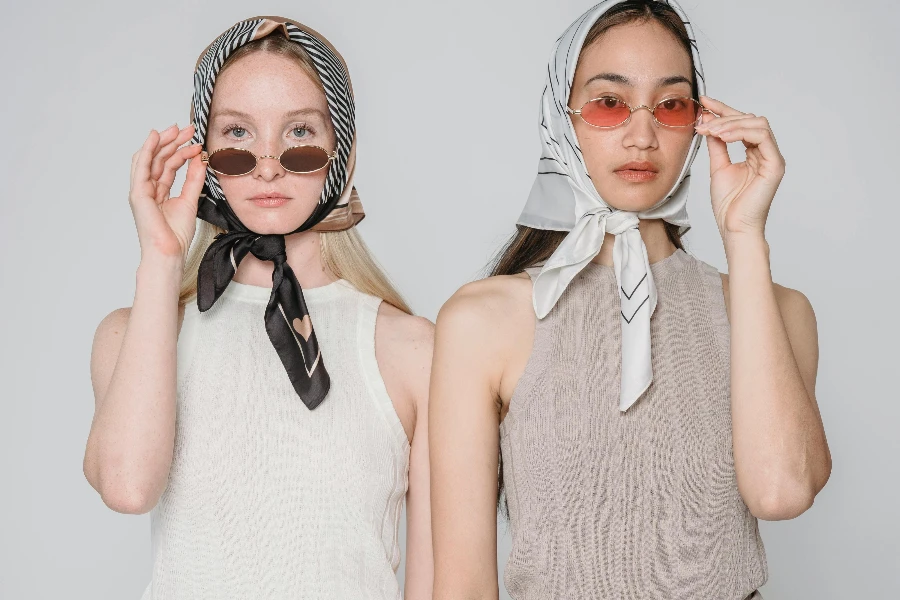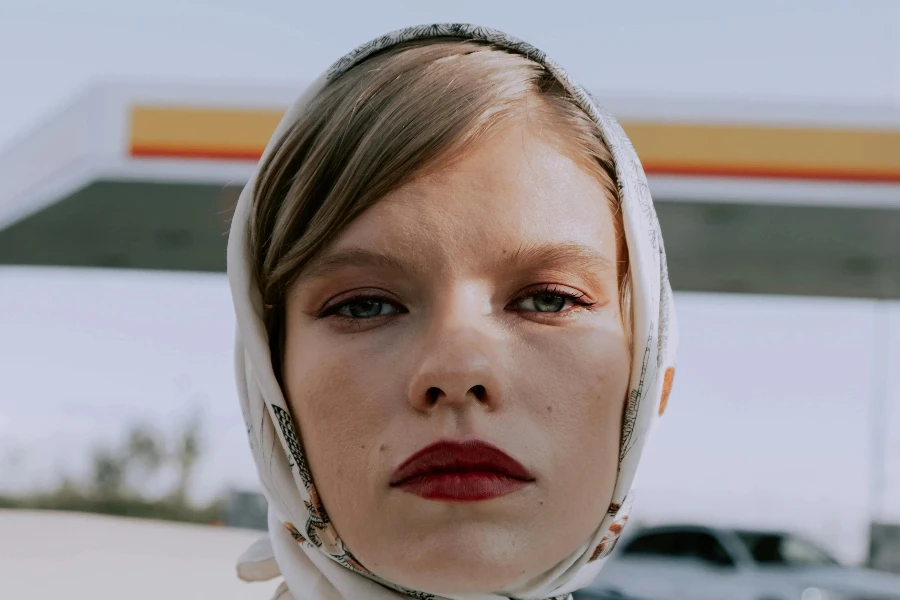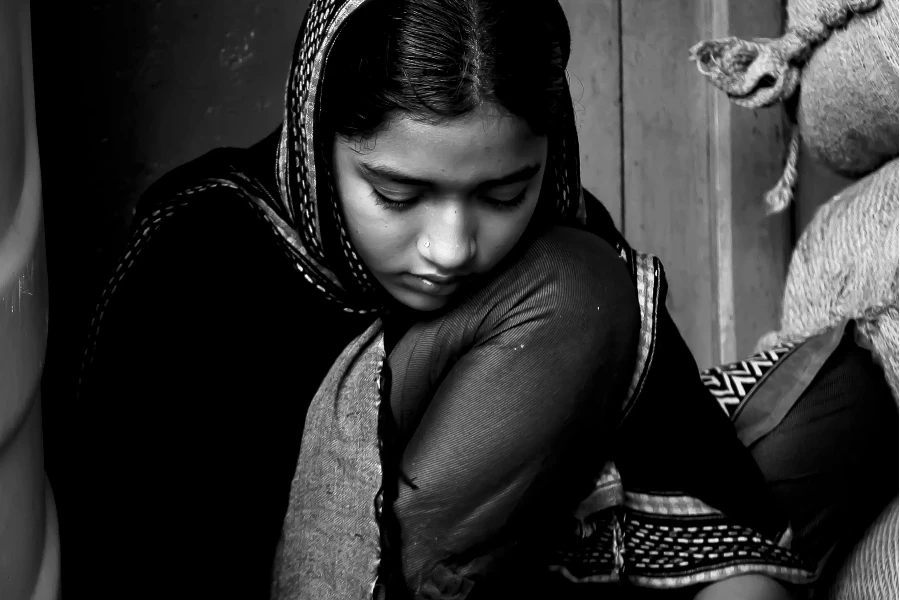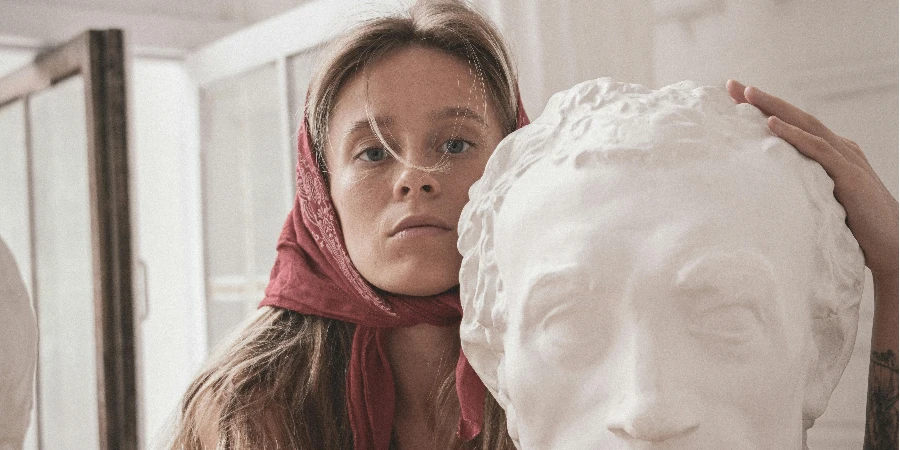وشاح الرأس هو أكثر من مجرد قطعة قماش؛ إنه ملحق متعدد الاستخدامات وله تاريخ غني واستخدامات متعددة الأوجه. سواء كنت تتطلع إلى إضفاء لمسة عصرية، أو حماية شعرك، أو استكشاف التقاليد الثقافية، فإن وشاح الرأس يوفر مزيجًا فريدًا من الأناقة والعملية. في هذا المقال، نتطرق إلى أهم جوانب أغطية الرأس، ونسلط الضوء على أهميتها ونقدم نصائح عملية لدمجها في خزانة ملابسك.
جدول المحتويات:
1. نبذة تاريخية عن غطاء الرأس
2. الأنواع والمواد
3. نصائح وتقنيات التصميم
4. الأهمية الثقافية والرمزية
5. الاستخدامات والفوائد العملية
تاريخ موجز لغطاء الرأس

لغطاء الرأس تاريخ عريق يعود إلى آلاف السنين. تم استخدام أغطية الرأس في الأصل لأغراض عملية، مثل الحماية من العناصر، وقد تطورت لتصبح رمزًا للمكانة والموضة والهوية.
تاريخيًا، كان يرتدي الرجال والنساء الحجاب في مختلف الثقافات. وفي مصر القديمة، كانوا علامة على النبل. وفي الوقت نفسه، في اليونان القديمة وروما، كانوا يوفرون الحماية من الشمس والرياح للعمال والجنود. شق هذا الملحق متعدد الوظائف طريقه تدريجيًا إلى الموضة السائدة، حيث يظل عنصرًا أساسيًا حتى اليوم.
في القرن العشرين، شهد غطاء الرأس انتعاشًا في شعبيته. قامت أيقونات مثل أودري هيبورن وجريس كيلي بترويج الوشاح الحريري الأنيق، في حين تبنت حركات الثقافة المضادة في الستينيات والسبعينيات المزيد من الأساليب البوهيمية. واليوم، لا يزال غطاء الرأس بمثابة إكسسوار ديناميكي، يعكس اتجاهات الموضة التقليدية والمعاصرة.
أنواع والمواد

تتوفر أغطية الرأس في مجموعة متنوعة من الأنواع والمواد، ولكل منها مزايا مميزة. يمكن أن يساعدك فهم هذه الاختلافات في اختيار الوشاح المناسب لاحتياجاتك.
الحرير والأوشحة: الأوشحة الحريرية، المعروفة بملمسها الفاخر وألوانها النابضة بالحياة، مثالية لمظهر أنيق ومتطور. الحرير خفيف الوزن وقابل للتنفس، مما يجعله مثاليًا للطقس الدافئ. ومع ذلك، فهي أيضًا حساسة وتتطلب معالجة دقيقة.
أوشحة قطنية: الأوشحة القطنية متعددة الاستخدامات وعملية. إنها مريحة وسهلة العناية ومناسبة للارتداء اليومي. كما أن خصائص القطن الماصة تجعله خيارًا جيدًا لأغطية الرأس في الطقس الدافئ أو أثناء الأنشطة البدنية.
أوشحة من الصوف: بالنسبة للمناخات الباردة، توفر الأوشحة الصوفية الدفء والعزل. أنها تأتي في مختلف النسج والسمك، وتوفير خيارات لمستويات مختلفة من الدفء. الصوف أيضًا متين ويمكنه تحمل الظروف الجوية القاسية.
الأوشحة الاصطناعية: الأوشحة الاصطناعية المصنوعة من مواد مثل البوليستر أو النايلون، غالبًا ما تكون أقل تكلفة ويمكن أن تحاكي شكل وملمس الألياف الطبيعية. فهي سهلة العناية بها ومقاومة للتجاعيد، مما يجعلها خيارًا مناسبًا للسفر.
نصائح وتقنيات التصميم

يمكن أن يؤدي دمج وشاح الرأس في خزانة ملابسك إلى الارتقاء بأسلوبك. إليك بعض النصائح والتقنيات لمساعدتك على تحقيق أقصى استفادة من هذا الملحق متعدد الاستخدامات.
التفاف كلاسيكي: إن أبسط طريقة لارتداء وشاح الرأس هي الغلاف الكلاسيكي. قم بطي الوشاح على شكل مثلث، ثم ضع الحافة الطويلة على طول جبهتك، واربط الأطراف عند مؤخرة رقبتك. هذا النمط الخالد يتماشى بشكل جيد مع الملابس غير الرسمية والرسمية.
نمط العمامة: للحصول على مظهر أكثر دراماتيكية، جربي أسلوب العمامة. ضعي الوشاح في الجزء الخلفي من رأسك، واجلبي الأطراف إلى الأمام، ولفيهما حول بعضهما البعض، ثم ضعيهما في الخلف. يضيف هذا النمط حجمًا وذوقًا إلى مجموعتك.
نمط باندانا: نمط المنديل مثالي لمظهر غير رسمي ومريح. قومي بطي الوشاح على شكل مثلث، ضعيه على رأسك بحيث يكون الطرف المدبب في الخلف، واربطي الأطراف تحت ذقنك أو في مؤخرة رأسك. هذا النمط عملي وعصري.
نمط عقال: لإضافة لمسة من الألوان أو الأنماط إلى تسريحة شعرك، استخدمي وشاح الرأس كعصابة رأس. قم بطي الوشاح على شكل شريط ضيق، ولفه حول رأسك، واربطه في الأعلى أو الأسفل. يحافظ هذا النمط على شعرك في مكانه مع إضافة لمسة أنيقة.
الأهمية الثقافية والرمزية

يحمل غطاء الرأس أهمية ثقافية عميقة ورمزية في مختلف المجتمعات. يمكن أن تمثل المعتقدات الدينية، أو الوضع الاجتماعي، أو التراث الثقافي، مما يجعلها رموزًا قوية للهوية.
في العديد من الثقافات الإسلامية، يتم ارتداء غطاء الرأس أو الحجاب كدليل على التواضع والالتزام الديني. تختلف الأنماط والمواد، مما يعكس التقاليد الإقليمية والتفضيلات الشخصية. وبالمثل، في المجتمعات المسيحية واليهودية الأرثوذكسية، يتم ارتداء أغطية الرأس كتعبير عن الإيمان والتواضع.
في الثقافات الأفريقية، غالبًا ما تُستخدم أغطية الرأس، المعروفة باسم جيلي أو دهوكو، للدلالة على الحالة الاجتماعية أو الحالة الاجتماعية أو الهوية العرقية. تعتبر تقنيات التغليف المعقدة والأقمشة النابضة بالحياة شهادة على تراث مرتديها وإبداعها.
في المجتمعات الغربية، تم اعتماد أغطية الرأس كأزياء، وغالبًا ما تكون منفصلة عن أصولها الثقافية. ومع ذلك، فإنها لا تزال تحمل دلالات الأناقة والرقي، والتي شاعتها أيقونات الموضة والمشاهير.
الاستخدامات والفوائد العملية

بالإضافة إلى جاذبيتها الجمالية، توفر أغطية الرأس مجموعة من الاستخدامات والفوائد العملية. إنها توفر الحماية والراحة والتنوع، مما يجعلها إكسسوارًا أساسيًا للكثيرين.
حماية: تحمي أوشحة الرأس شعرك وفروة رأسك من أشعة الشمس فوق البنفسجية الضارة، مما يساعد على منع حروق الشمس والضرر. كما أنها تحمي من الرياح والغبار، مما يحافظ على شعرك نظيفًا وخاليًا من التشابك.
الراحة: في الطقس البارد، توفر الأوشحة الصوفية أو الصوفية الدفء والعزل، بينما في الطقس الحار، تحافظ الأقمشة خفيفة الوزن مثل القطن أو الحرير على انتعاشك وتمتص العرق. يمكن أن توفر أغطية الرأس أيضًا الراحة لأولئك الذين يخضعون للعلاجات الطبية، وتوفر طريقة أنيقة لتغطية تساقط الشعر.
تعدد الاستخدام: يمكن تصميم أوشحة الرأس بعدة طرق لتناسب المناسبات المختلفة. سواء كنت بحاجة إلى غطاء شعر عملي للتمرين أو إكسسوار أنيق لحدث رسمي، فهناك نمط وشاح الرأس الذي يناسب الفاتورة. كما أنها سهلة الحمل، مما يجعلها خيارًا مناسبًا للسفر.
وفي الختام
وشاح الرأس هو إكسسوار خالد يمزج بين الأسلوب والوظيفة والأهمية الثقافية. من خلال فهم تاريخها وأنواعها واستخداماتها، يمكنك تقدير التنوع والقيمة التي تضيفها إلى خزانة ملابسك. سواء كنت ترتديه من أجل الموضة أو الحماية أو التعبير الثقافي، يظل وشاح الرأس رمزًا قويًا للهوية والأناقة.




